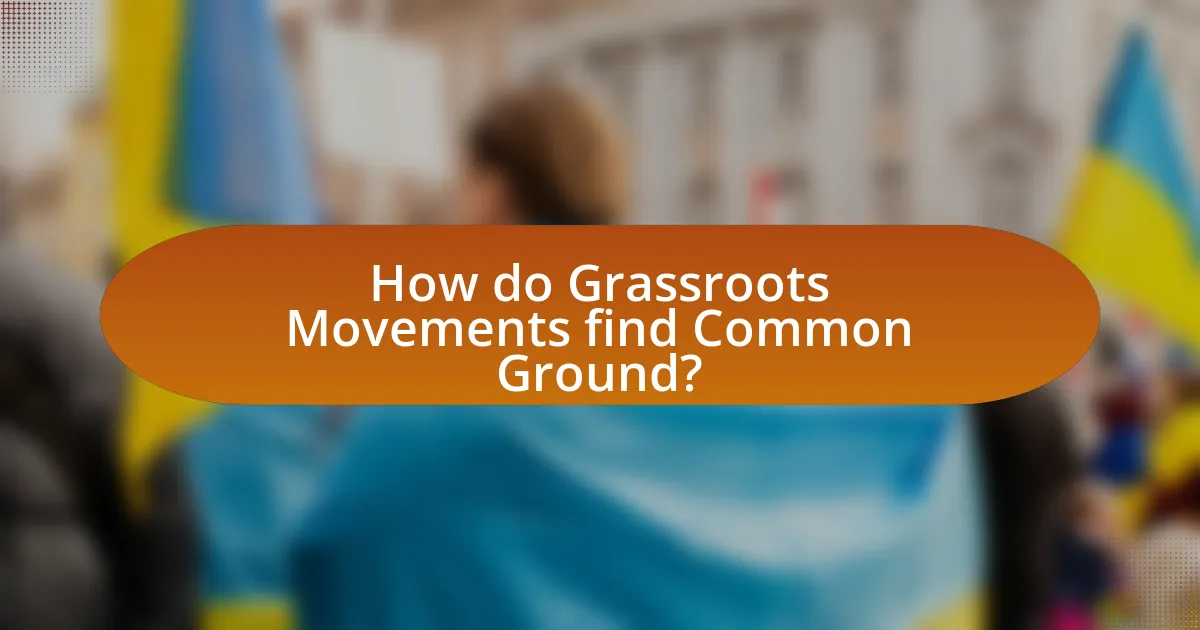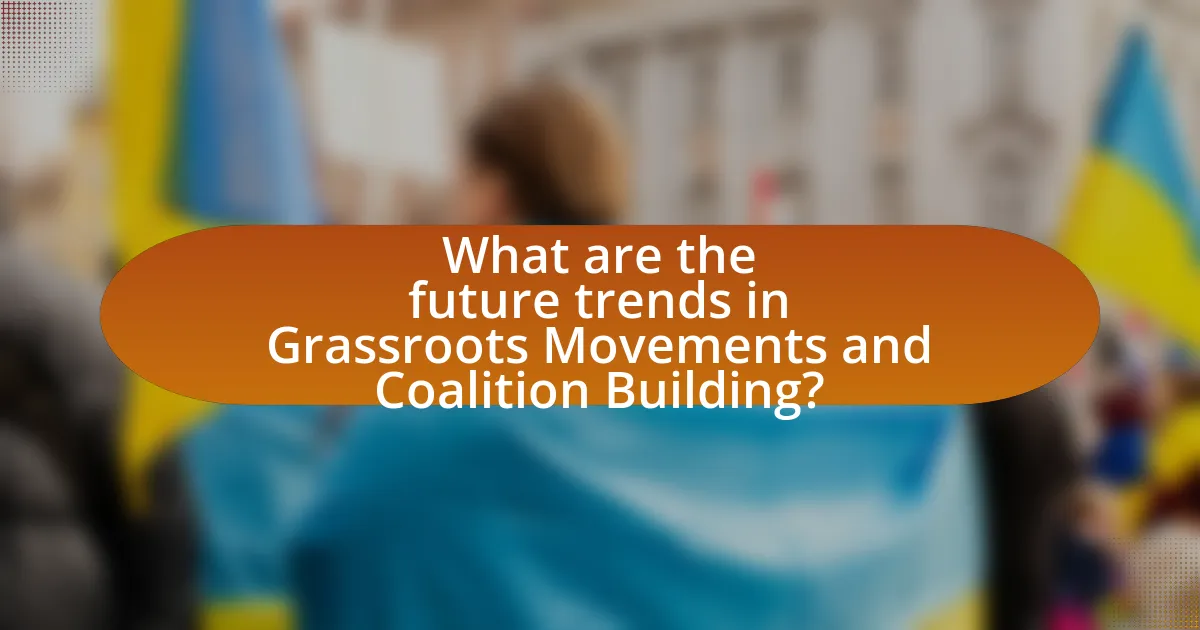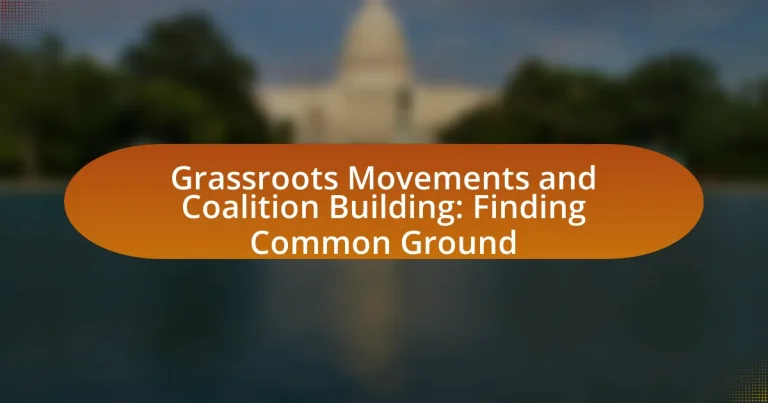Grassroots movements are organized efforts by ordinary people at the community level aimed at achieving social or political change, often through local issues. Coalition building involves forming alliances among diverse groups to enhance their collective impact on shared goals. This article explores how grassroots movements initiate change, the characteristics that define them, and the importance of coalition building in amplifying voices and enhancing effectiveness. It also addresses the challenges faced in coalition dynamics, strategies for finding common ground, and the role of technology in shaping future grassroots activism. Key trends include increased digital engagement, intersectionality, and a focus on local issues, highlighting the evolving landscape of grassroots movements and coalition building.

What are Grassroots Movements and Coalition Building?
Grassroots movements are organized efforts by ordinary people at the community level to effect social or political change, often driven by local issues and concerns. Coalition building refers to the process of forming alliances among diverse groups or organizations to strengthen their collective impact on a shared goal. For instance, the Civil Rights Movement in the United States exemplified grassroots activism, where local communities mobilized to challenge systemic racism, while coalition building was evident in the collaboration between various civil rights organizations to amplify their voices and resources.
How do Grassroots Movements initiate change?
Grassroots movements initiate change by mobilizing community members to advocate for social, political, or environmental issues. These movements often begin at the local level, where individuals identify shared concerns and organize collective action to influence decision-makers. For example, the Civil Rights Movement in the United States was driven by grassroots efforts that united individuals to challenge systemic racism and demand equal rights, leading to significant legislative changes such as the Civil Rights Act of 1964. This demonstrates that grassroots movements can effectively create change by fostering community engagement and leveraging collective power to address pressing issues.
What are the key characteristics of Grassroots Movements?
Grassroots movements are characterized by their community-driven nature, emphasizing local participation and activism. These movements typically arise from the collective efforts of individuals at the local level, seeking to address specific social, political, or environmental issues. They often rely on volunteer efforts and grassroots organizing techniques, such as door-to-door campaigning and community meetings, to mobilize support and raise awareness.
Additionally, grassroots movements prioritize inclusivity and democratic decision-making, allowing diverse voices within the community to contribute to the movement’s goals. They frequently utilize social media and digital platforms to amplify their message and connect with a broader audience. Historical examples, such as the Civil Rights Movement in the United States, illustrate how grassroots efforts can lead to significant societal change, demonstrating the effectiveness of local activism in influencing national policies.
How do local communities influence Grassroots Movements?
Local communities significantly influence grassroots movements by providing the foundational support, resources, and local knowledge necessary for mobilization. These communities often serve as the initial incubators for ideas and actions, where shared experiences and common grievances unite individuals around a cause. For instance, the Civil Rights Movement in the United States was heavily driven by local communities organizing protests and advocating for change, demonstrating how grassroots efforts can emerge from localized concerns. Additionally, research indicates that grassroots movements are more effective when they are rooted in the specific needs and contexts of local populations, as seen in studies highlighting the success of community-led initiatives in environmental justice. This localized engagement fosters a sense of ownership and accountability, which is crucial for sustaining momentum and achieving long-term goals.
Why is Coalition Building important in Grassroots Movements?
Coalition building is important in grassroots movements because it enhances collective power and amplifies voices for social change. By uniting diverse groups with shared goals, grassroots movements can leverage a broader base of support, resources, and expertise, which increases their effectiveness. For instance, the Civil Rights Movement in the United States successfully utilized coalition building among various organizations, such as the NAACP and SCLC, to achieve significant legislative changes like the Civil Rights Act of 1964. This historical example illustrates how coalition building can lead to tangible outcomes by fostering solidarity and collaboration among different stakeholders.
What roles do coalitions play in amplifying voices?
Coalitions play a crucial role in amplifying voices by uniting diverse groups to advocate for common causes. This collective strength enhances visibility and influence, allowing marginalized voices to be heard more effectively. For instance, coalitions like the Women’s March have successfully mobilized millions, demonstrating that collaborative efforts can lead to significant social and political change. By pooling resources, sharing platforms, and coordinating messaging, coalitions ensure that a broader spectrum of perspectives is represented, thereby increasing the impact of their advocacy.
How do coalitions enhance the effectiveness of Grassroots Movements?
Coalitions enhance the effectiveness of grassroots movements by pooling resources, amplifying voices, and increasing visibility. When grassroots organizations unite, they can share funding, expertise, and networks, which strengthens their collective impact. For instance, the coalition of various environmental groups during the 2014 People’s Climate March mobilized over 400,000 participants, demonstrating how collaboration can significantly elevate public engagement and media attention. This collaborative approach not only broadens the reach of individual movements but also fosters a sense of solidarity, making it easier to advocate for shared goals and influence policy changes.
What challenges do Grassroots Movements face in Coalition Building?
Grassroots movements face significant challenges in coalition building, primarily due to differing priorities and goals among diverse groups. These movements often represent a wide range of interests, which can lead to conflicts over resource allocation, messaging, and strategies. For instance, a study by the Institute for Social Movements highlights that when grassroots organizations attempt to unite, they frequently encounter issues related to power dynamics, where larger or more established groups may dominate discussions, sidelining smaller voices. Additionally, varying levels of commitment and engagement among coalition members can hinder effective collaboration, as seen in the case of the Climate Justice Alliance, where disparities in resources and organizational capacity affected collective action. These challenges underscore the complexities grassroots movements face in achieving unity and effectiveness in their coalition efforts.
How do differing agendas impact coalition dynamics?
Differing agendas significantly impact coalition dynamics by creating tensions and challenges in collaboration. When coalition members prioritize distinct goals, it can lead to conflicts over resource allocation, strategic direction, and decision-making processes. For instance, research by the National Democratic Institute highlights that coalitions with divergent agendas often struggle to maintain unity, as members may prioritize their individual objectives over collective goals, resulting in fragmentation. This fragmentation can weaken the coalition’s overall effectiveness and diminish its ability to advocate for shared interests, ultimately undermining the coalition’s purpose and success.
What are common obstacles to collaboration among diverse groups?
Common obstacles to collaboration among diverse groups include communication barriers, differing priorities, and cultural misunderstandings. Communication barriers arise from language differences and varying communication styles, which can lead to misinterpretations and frustration. Differing priorities often stem from the unique goals and values of each group, making it challenging to align on a common mission. Cultural misunderstandings can create tension, as diverse backgrounds may influence perspectives and approaches to problem-solving. These obstacles hinder effective collaboration and can impede the success of grassroots movements and coalition building.

How do Grassroots Movements find Common Ground?
Grassroots movements find common ground by fostering inclusive dialogue among diverse stakeholders. This process often involves identifying shared goals and values, which can unite individuals from different backgrounds. For instance, the Civil Rights Movement in the United States successfully brought together various groups by emphasizing the universal principles of equality and justice, allowing for a broad coalition that included African Americans, labor unions, and religious organizations. Additionally, grassroots movements utilize community organizing techniques to engage participants in discussions that highlight common interests, thereby building solidarity and collective action.
What strategies do Grassroots Movements use to build coalitions?
Grassroots movements build coalitions through strategies such as inclusive outreach, shared goals, and leveraging social media. Inclusive outreach involves engaging diverse community members to ensure representation and broaden support. Shared goals create a unified vision that aligns various stakeholders, enhancing collaboration. Leveraging social media facilitates rapid communication and mobilization, allowing movements to reach wider audiences and coordinate efforts effectively. For instance, the Black Lives Matter movement utilized these strategies to unite various organizations and individuals around the common goal of racial justice, demonstrating the effectiveness of coalition-building in grassroots activism.
How do shared goals facilitate collaboration?
Shared goals facilitate collaboration by aligning the interests and efforts of individuals or groups towards a common objective. When participants have a clear understanding of shared goals, they are more likely to communicate effectively, coordinate their actions, and leverage each other’s strengths. Research indicates that collaboration is enhanced when team members are motivated by a unified purpose, as it fosters trust and reduces conflicts. For instance, a study published in the Journal of Applied Psychology found that teams with shared goals demonstrated higher performance levels and greater satisfaction among members, highlighting the importance of common objectives in driving collaborative success.
What role does communication play in finding common ground?
Communication is essential in finding common ground as it facilitates understanding and collaboration among diverse groups. Effective communication allows individuals to express their perspectives, share experiences, and identify shared values, which are crucial for building trust and fostering cooperation. Research indicates that open dialogue can reduce misunderstandings and conflicts, enabling groups to align their goals and work towards collective objectives. For instance, studies in community organizing demonstrate that successful coalitions often rely on transparent communication strategies to engage stakeholders and create a unified vision.
Why is inclusivity vital in Grassroots Movements?
Inclusivity is vital in grassroots movements because it ensures diverse perspectives and experiences are represented, which enhances the movement’s effectiveness and reach. When grassroots movements include individuals from various backgrounds, they can address a wider array of issues and resonate with a larger audience. Research indicates that inclusive movements are more successful in mobilizing support; for example, the Women’s March in 2017 attracted millions globally by embracing intersectionality, highlighting the importance of various identities and experiences. This broad participation not only strengthens the movement’s legitimacy but also fosters solidarity and collective action, ultimately leading to more impactful social change.
How does diversity strengthen coalition efforts?
Diversity strengthens coalition efforts by bringing together varied perspectives, experiences, and skills that enhance problem-solving and innovation. When individuals from different backgrounds collaborate, they can identify and address issues more comprehensively, leading to more effective strategies. Research indicates that diverse teams are 35% more likely to outperform their homogeneous counterparts in terms of performance and creativity, as highlighted in a study by McKinsey & Company. This diversity fosters a richer dialogue, encourages empathy, and builds trust among coalition members, ultimately leading to more robust and sustainable grassroots movements.
What practices promote equitable participation in coalitions?
Practices that promote equitable participation in coalitions include establishing clear communication channels, ensuring diverse representation, and fostering an inclusive decision-making process. Clear communication channels allow all members to express their views and concerns, which is essential for transparency and trust. Diverse representation ensures that various perspectives are included, reflecting the community’s demographics and needs. An inclusive decision-making process empowers all coalition members to contribute to discussions and decisions, thereby enhancing ownership and commitment to coalition goals. Research indicates that coalitions with these practices are more effective in achieving their objectives and sustaining engagement over time.
How can Grassroots Movements measure success in Coalition Building?
Grassroots movements can measure success in coalition building through the establishment of shared goals, increased membership engagement, and the achievement of specific policy outcomes. By defining clear, collective objectives, movements can assess whether coalition partners are aligned and actively contributing to these aims. Engagement metrics, such as participation rates in events and initiatives, provide quantifiable data on member involvement and commitment. Additionally, successful coalitions often lead to tangible policy changes or community impacts, which serve as concrete indicators of effectiveness. For instance, the successful passage of legislation or the implementation of community programs can directly reflect the coalition’s influence and collaborative efforts.
What metrics indicate effective collaboration?
Effective collaboration is indicated by metrics such as communication frequency, shared goals achievement, and participant engagement levels. Communication frequency measures how often team members interact, which correlates with improved understanding and alignment. Shared goals achievement assesses the extent to which collaborative objectives are met, reflecting the effectiveness of teamwork. Participant engagement levels gauge the involvement and commitment of individuals in the collaborative process, with higher engagement often leading to better outcomes. These metrics are supported by research showing that teams with frequent communication and clear goals are more successful in achieving their objectives.
How do Grassroots Movements assess their impact on communities?
Grassroots movements assess their impact on communities through a combination of qualitative and quantitative methods, including surveys, community feedback, and outcome measurements. These movements often conduct surveys to gather data on community needs and perceptions before and after initiatives, allowing them to measure changes in awareness, engagement, and satisfaction. For example, a grassroots organization may implement a community health program and subsequently survey participants to evaluate improvements in health outcomes or access to services. Additionally, they may hold community forums to collect direct feedback, which provides insights into the effectiveness of their efforts and areas for improvement. This approach ensures that the assessment is grounded in the lived experiences of community members, making the evaluation process both relevant and impactful.

What are the future trends in Grassroots Movements and Coalition Building?
Future trends in grassroots movements and coalition building include increased digital engagement, intersectionality, and a focus on local issues. Digital platforms enable grassroots organizations to mobilize supporters quickly and effectively, as seen in movements like Black Lives Matter, which utilized social media for widespread awareness and action. Intersectionality is becoming crucial as movements recognize the interconnectedness of various social justice issues, leading to broader coalitions that address multiple forms of oppression. Additionally, there is a growing emphasis on local issues, as communities seek to address specific needs and challenges, fostering stronger ties among coalition members and enhancing grassroots effectiveness. These trends reflect a shift towards more inclusive, adaptive, and technology-driven approaches in grassroots activism.
How is technology influencing Grassroots Movements?
Technology is significantly influencing grassroots movements by enhancing communication, mobilization, and fundraising efforts. Social media platforms enable activists to reach wider audiences quickly, facilitating the rapid dissemination of information and organizing events. For instance, the #BlackLivesMatter movement utilized Twitter and Facebook to coordinate protests and share resources, resulting in increased visibility and support. Additionally, crowdfunding platforms like GoFundMe have empowered grassroots organizations to raise funds directly from supporters, bypassing traditional funding barriers. This technological integration has led to more effective coalition building and sustained engagement in social justice initiatives.
What digital tools are enhancing coalition efforts?
Digital tools enhancing coalition efforts include social media platforms, collaborative project management software, and communication applications. Social media platforms like Facebook and Twitter facilitate outreach and mobilization by allowing coalitions to share information quickly and engage with a broader audience. Collaborative project management software, such as Trello and Asana, enables coalition members to coordinate tasks and track progress efficiently. Communication applications like Slack and Zoom enhance real-time interaction and foster collaboration among diverse groups, making it easier to organize and strategize. These tools collectively improve the effectiveness and reach of grassroots movements and coalition building.
How does social media shape public engagement in Grassroots Movements?
Social media significantly shapes public engagement in grassroots movements by providing a platform for rapid information dissemination and community mobilization. This digital landscape allows grassroots organizations to reach a wider audience, facilitating real-time communication and coordination among supporters. For instance, the Black Lives Matter movement effectively utilized Twitter and Facebook to organize protests and share critical information, resulting in increased visibility and participation. Research indicates that social media can enhance civic engagement, with a study by the Pew Research Center showing that 69% of adults in the U.S. believe social media helps them connect with others who share their views, thereby amplifying grassroots efforts.
What emerging issues are Grassroots Movements addressing?
Grassroots movements are addressing emerging issues such as climate change, social justice, economic inequality, and political corruption. These movements mobilize communities to advocate for sustainable environmental practices, equitable treatment of marginalized groups, fair economic policies, and transparent governance. For instance, the global climate strikes led by youth activists highlight the urgent need for action against climate change, while movements like Black Lives Matter focus on combating systemic racism and police brutality. These issues reflect a growing awareness and demand for change at the community level, demonstrating the power of grassroots activism in shaping public discourse and policy.
How are environmental concerns shaping new coalitions?
Environmental concerns are driving the formation of new coalitions by uniting diverse groups around shared sustainability goals. These coalitions often include environmental organizations, community activists, and businesses that prioritize eco-friendly practices. For instance, the rise of climate change awareness has led to partnerships like the We Are Still In coalition, which comprises over 3,800 leaders from various sectors committed to upholding the Paris Agreement. This collaboration illustrates how environmental issues can transcend traditional boundaries, fostering alliances that enhance collective action and resource sharing.
What role do social justice movements play in future coalitions?
Social justice movements play a crucial role in shaping future coalitions by advocating for equity and inclusivity across diverse social issues. These movements mobilize communities, raise awareness about systemic injustices, and create platforms for marginalized voices, thereby fostering solidarity among various groups. For instance, the Black Lives Matter movement has successfully allied with environmental justice organizations, demonstrating how social justice initiatives can unite different causes under a common goal of equity. This intersectionality enhances coalition-building efforts, as evidenced by the increased collaboration seen during events like the Women’s March, which brought together various social justice advocates to address multiple issues simultaneously.
What best practices can enhance future Grassroots Movements?
To enhance future grassroots movements, establishing clear communication channels is essential. Effective communication fosters transparency, builds trust, and ensures that all participants are informed and engaged. Research indicates that movements with strong communication strategies, such as the use of social media platforms, can mobilize support more efficiently; for example, the Arab Spring utilized social media to organize protests and spread awareness rapidly. Additionally, creating inclusive spaces for diverse voices encourages broader participation and strengthens the movement’s impact. Studies show that inclusive movements, like the Women’s March, attract a wider audience and generate more significant media attention, amplifying their message. Finally, setting measurable goals and regularly assessing progress allows grassroots movements to adapt strategies effectively, ensuring sustained momentum and relevance.
How can leaders foster collaboration among diverse groups?
Leaders can foster collaboration among diverse groups by creating an inclusive environment that values different perspectives. This can be achieved through active listening, encouraging open dialogue, and establishing common goals that resonate with all members. Research indicates that diverse teams are more innovative and effective when leaders facilitate trust and respect among participants, as shown in a study by the Harvard Business Review, which found that inclusive teams outperform their peers by 35% in decision-making. By implementing structured collaboration processes and promoting shared ownership of outcomes, leaders can enhance engagement and cooperation across diverse groups.
What lessons can be learned from successful Grassroots Movements?
Successful grassroots movements demonstrate the importance of community engagement and collective action in driving social change. These movements often rely on building strong local networks, which fosters trust and collaboration among participants. For instance, the Civil Rights Movement in the United States effectively mobilized communities through grassroots organizing, leading to significant legislative changes such as the Civil Rights Act of 1964. Additionally, successful grassroots movements highlight the necessity of clear messaging and a unified vision, as seen in the Women’s March, which galvanized millions around shared goals of equality and justice. These examples illustrate that grassroots movements can achieve substantial impact by leveraging local support, maintaining clear communication, and fostering a sense of shared purpose among diverse groups.


